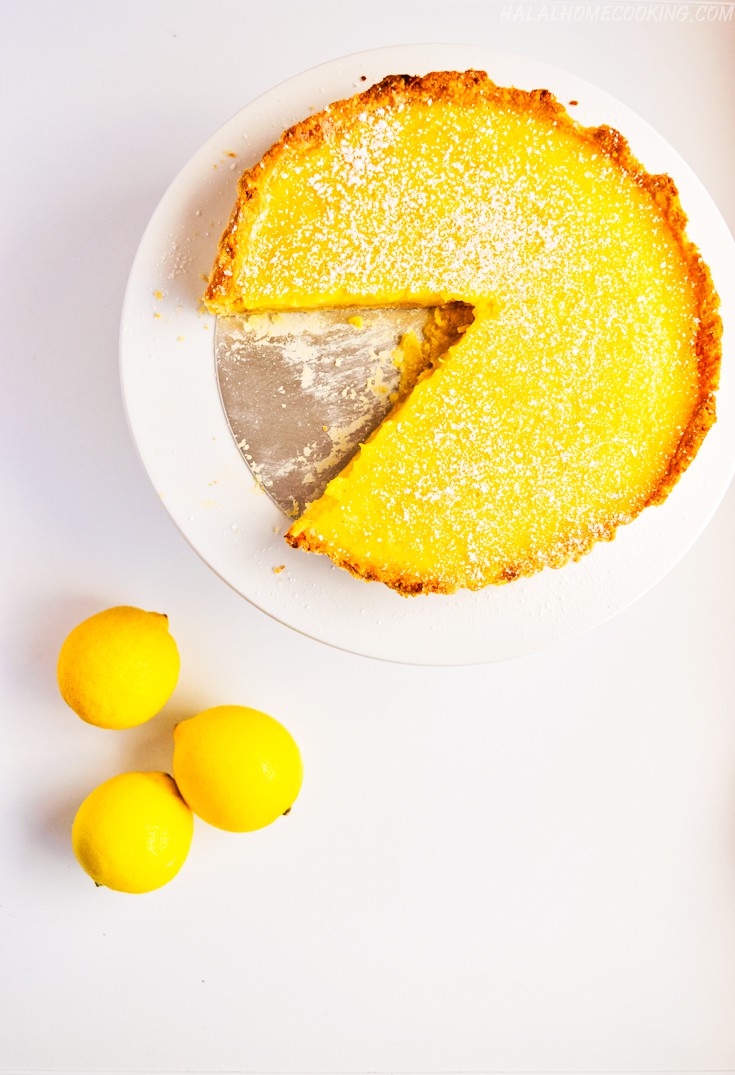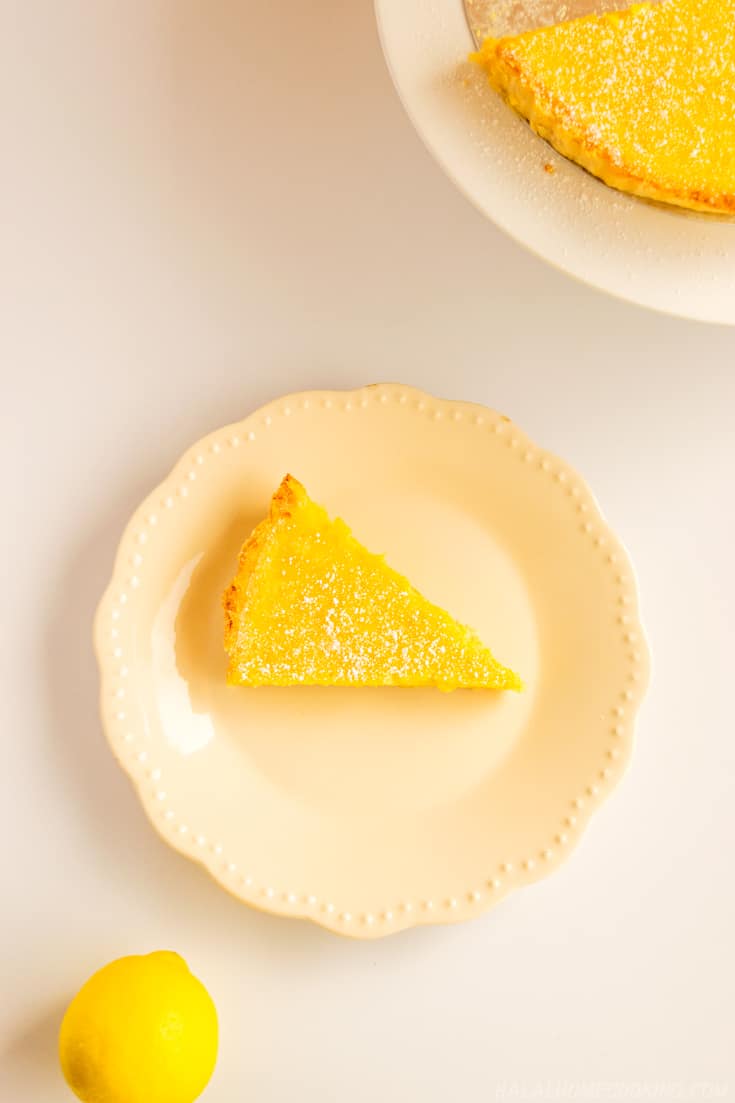Tarte Au Citron – Lemon Tart
A buttery sweet shortcrust pastry, encasing a rich baked lemon custard.
I absolutely L.O.V.E lemon-anything and everything! Lemons not only look pretty – give me a bowl of lemons instead of a bouquet of flowers and I’ll be happy, they bring freshness and sourness to many a baked good, dessert, drink, chicken and fish dish! Lemon juice in particular brightens the flavours of heavy dishes, such as curries and soups when added at the end of cooking.
It’s been a while since I purchased any new bake-ware but for a long time I’ve had my sights set on baking Mary Berry’s Tarte Au Citron, so I took the plunge and invested in a 23cm fluted tart tin. I’m so glad I did, as I got satisfactory results first time الحمد لله
That being said, I could certainly improve things next time ان شاء الله.
For instance; I had a near disaster when trimming the excess pastry from the sides of the tin. Whatever you do, DO NOT lift the tart tin off the baking tray to try to get a better cutting angle, you will push the loose base up, along with the barely set pastry case – panic and maybe say a few words you regret later, before pulling yourself together and somehow rescuing the situation.
Not without a casualty, by that I mean a chip(s) on the rim of the pastry case, which later will show itself all too well. When you come to fill the case, the custard will be going in fine until it reaches the level of the chipped rim in the pastry case and then start flowing over said chip. At this point you stop and realise you can’t continue to fill, so you discard the custard and bake the almost-full with lemon-custard tart. Looking back, I now see I could have poured the excess custard into a ramekin and baked it in a bain-marie for a crust-less tart / baked set-custard.
Well, as it turns out ما شاء الله the tart still needed to be baked 30-35 minutes, as instructed on the original recipe and until the custard still has a slight wobble in the centre. You bring the tarte au citron out of the oven at this stage as the custard will continue to cook as it cools and you want a fully set, but not overcooked custard.
This lemon tart reminds me very much of a baked lemon cheesecake. All be it without the cream cheese and not as thick. It has that same tartness balanced out with plenty of sugar.
Speaking of sugar, I used unrefined golden caster sugar in the custard (next time I may reduce the amount, only slightly) but you could easily get away with using white caster sugar, like the original recipe. I prefer using unrefined sugars where possible, although more expensive they are healthier when consumed in moderate amounts. Errrm….not sure if the amount of sugar in this tart, refined or unrefined is considered moderate! The wonderful thing about this is, you can have just a thin slice and it will definitely satisfy. Sometimes a thin slice is all you will be able to grab, hoping to save some for the following day. Then before you know it, your loved ones slowly but surely devour the entire tart within the first day and you’re left thinking, I thought he wasn’t big on lemon-flavoured desserts?!
I made the sweet shortcrust pastry – Pâte sucrée the old-fashioned way – using my hands and a butter knife, where as Mary Berry uses a food processor. I’ve tried the food processor method for shortcrust pastry in the past with quite pleasing results, but now my food processor is broke and I figured not everyone is going to have a food processor and sometimes the old methods are the best! I haven’t got any step-by-step photos, but once I make the tart again and believe me I will, then I will update the post ان شاء الله
This bake takes time, hands-off waiting time mostly. From the chilling of the sweet pastry to the chilling of the unbaked sweet pastry case. That makes this tarte au citron an ideal weekend bake! so go on, try it and let me know what you think.
Tarte Au Citron – Lemon Tart
Ingredients
- 175g/6oz plain flour
- 100g/3½oz cold unsalted butter, cut into small cubes
- 25g/1oz icing sugar
- 1 free-range egg yolk
- 1-3 tbsp cold water
- 5 free-range eggs
- 125ml/4fl oz double (heavy) cream
- 225g/8oz unrefined golden caster sugar (or white)
- 4 lemons, juice and zest
- icing sugar, for dusting
Instructions
- To make the pastry, stir the flour and icing sugar together in a medium size bowl then using your hands rub the butter into the flour mixture until it resembles breadcrumbs. Make a well in the centre of the buttery flour mixture, add the egg yolk and water, stir with a butter-knife and then bring it together with your hands. Wrap the pastry in cling-film (plastic wrap) and put it in the fridge to chill for 15 minutes.
- Grease a 23cm/9in loose-bottomed, fluted tart tin.
- Lay a piece of parchment paper on the work surface. Remove the base from the tart tin and lay it on the paper. Using a pencil, draw a circle onto the paper 4cm/1½in bigger than the tin base.
- Dust the base of the tin with flour. Place the pastry ball in the centre of the tin base and flatten it out slightly. Roll out the pastry, still on the base, until it meets the circle mark. As you are rolling out, turn the pastry by turning the paper. Gently fold the pastry surrounding the tin base in towards the centre.
- Carefully lift the tin base off the work surface, drop it into the tin, then ease the pastry into the corners and up the sides of the tin, pressing the overhang lightly over the rim. If the pastry has cracked at all, simply press it together to seal. Press the pastry into the flutes of the tin then lightly prick the base with a fork, but not quite all the way through. Place the pastry-lined tin on a baking tray, cover loosely with cling film and chill in the fridge for 30 minutes. Meanwhile, prepare your lemons and measure the rest of your filling ingredients (don’t mix them just yet) and preheat the oven to 200C/400F/Gas 6.
- Remove the cling film from the pastry case and line with foil so it supports the sides, then fill with baking beans or rice/lentils etc. Bake blind for 12-15 minutes on the middle shelf, until the pastry is set, then lift out the foil and beans. Carefully trim the excess pastry from the sides using a sharp knife, holding the knife at a sharp angle and slicing away from you – don’t be tempted to pick up the tart tin from the baking tray to help with this. Remove the trimmings from the sheet. Return the empty pastry case to the oven for another 10-12 minutes or until it is pale golden and completely dry. Set aside to cool while you make the filling. Reduce the oven temperature to 170C/325F/Gas 3.
- For the filling, break the eggs into a large bowl and whisk together with a wire whisk. Add the rest of the filling ingredients and whisk again until they are all well combined. Pour the filling mixture into a jug, then into the cooled baked pastry case.To prevent it spilling as it goes in the oven, pour in most of the filling so it almost fills the tart, carefully sit the baking sheet and tart on the oven shelf, then top up with the rest of the filling to completely fill it (or if you have a chip(s) on the outer rim causing the pastry case to be shorter in places, fill only to that point so the custard doesn’t overflow). Bake for about 30-35 minutes or until just set but with a slight wobble in the centre.
- Leave to cool slightly then, when the pastry seems firm enough, remove the tart from the tin. The easiest way to do this is to place the base of the tin on an upturned can or jam jar and let the outer ring fall to the work surface. Transfer the tart to a serving plate and serve warm or cold, dusted with sifted icing sugar.
Notes
If you are not planning on eating the cooked tart straight away don’t dust with icing sugar until serving because once you put the tart into the fridge, if it has icing sugar on the surface this will pick up the moisture in the fridge and leave a slight watery film on the surface, it’s not unpleasant so to speak, but the pretty icing sugar will disappear.



